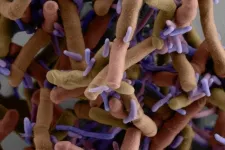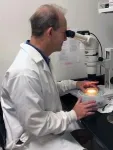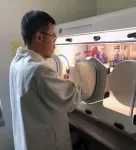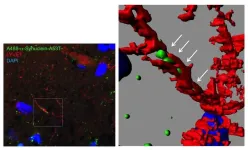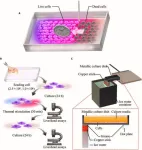(Press-News.org) Patescibacteria are a group of puzzling, tiny microbes whose manner of staying alive has been difficult to fathom. Scientists can cultivate only a few types, yet these bacteria are a diverse group found in many environments.
The few types of Patescibacteria that researchers can grow in the lab reside on the cell surfaces of another, larger host microbe. Patescibacteria in general lack the genes required to make many molecules necessary for life, such as the amino acids that make up proteins, the fatty acids that form membranes, and the nucleotides in DNA. This has led researchers to speculate that many of them rely on other bacteria to grow.
In a study published Sept. 7 in Cell, researchers present the first glimpse into the molecular mechanisms behind the unusual Patescibacteria lifestyle. This breakthrough was made possible by the discovery of a way to genetically manipulate these bacteria, an advance that has opened a world of possible new research directions.
"While metagenomics can tell us which microbes live on and within our bodies, the DNA sequences alone do not give us insight into their beneficial or detrimental activities, especially for organisms that have never before been characterized,” said Nitin S. Baliga of the Institute for System Biology in Seattle, which contributed many computational and systems analyses to the study.
“The ability to genetically perturb Patescibacteria opens up the possibility of applying a powerful systems analysis lens to rapidly characterize the unique biology of obligate epibionts,” he added, in reference to organisms that must live on another organism to survive.
The teams behind the study, headed by Joseph Mougous’ lab in the Department of Microbiology at the University of Washington School of Medicine and the Howard Hughes Medical Institute, were interested in Patescibacteria for several reasons.
They are among the many poorly understood bacteria whose DNA sequences pop up in large-scale genetic analyses of genomes found in species-rich microbial communities from environmental sources. This genetic material is referred to as “microbial dark matter” because little is known about the functions it encodes.
Microbial dark matter is likely to contain information about biochemical pathways with potential biotechnology applications, according to the Cell paper. It also holds clues to the molecular activities that support a microbial ecosystem, as well as to the cell biology of the assorted microbial species gathered in that system.
The group of Patescibacteria analyzed in this latest research belongs to the Saccharibacteria. These live in a variety of land and water environments but are best known for inhabiting the human mouth. They have been part of the human oral microbiome at least since the Middle Stone Age and have been linked to human oral health.
In the human mouth, Saccharibacteria require the company of Actinobacteria, which serve as their hosts. To better understand the mechanisms employed by Saccharibacteria to relate with their hosts, the researchers used genetic manipulation to identify all the genes essential for a Saccharibacterium to grow.
“We are tremendously excited to have this initial glimpse into the functions of the unusual genes these bacteria harbor,” said Mougous, professor of microbiology. “By focusing our future studies on these genes, we hope to unravel the mystery of how Saccharibacteria exploit host bacteria for their growth.”
Possible host-interaction factors uncovered in the study include cell surface structures that may help Saccharibacteria attach to host cells, and a specialized secretion system that might be used for transporting nutrients.
Another application of the authors’ work was the generation of Saccharibacteria cells that express fluorescent proteins. With these cells, the researchers performed time-lapse microscopic fluorescent imaging of Saccharibacteria growing with their host bacteria.
“Time-lapse imaging of Saccharibacteria-host cell cultures revealed surprising complexity in the lifecycle of these unusual bacteria,” noted S. Brook Peterson, a senior scientist in the Mougous lab.
The researchers reported that some Saccharibacteria serve as mother cells by adhering to the host cell and repeatedly budding to generate small swarmer offspring. These little ones move on to search for new host cells. Some of the progeny, in turn, became mother cells, while others appeared to interact unproductively with a host.
The researchers think that additional genetic manipulation studies will open the door to wider understanding of the roles of what they described as “the rich reserves of microbial dark matter these organisms contain” and potentially uncover yet unimagined biological mechanisms.
This interdisciplinary and collaborative study was fostered by the newly created Microbial Interactions & Microbiome Center (called by its acronym mim_c), which Mougous directs. The mission of mim_c is to lower barriers to microbiome research studies and advance collaborations through connections of like-minded researchers from across disciplines. Here, mim_c was the catalyst joining the Mougous lab with oral microbiome expert Jeffrey McClean in the Department of Periodontics, UW School of Dentistry.
The lead authors on this study were Yaxi Wang and Larry A. Gallagher of the UW Department of Microbiology. The senior authors were Baliga, Peterson and Mougous. Biochemists Qian Cong from University of Texas Southwestern, and David Baker and other researchers from the UW Medicine Institute for Protein Design also contributed to the work, along with McClean.
Mougous and Baker are Howard Hughes Medical Institute investigators. Mougous holds the Lynn M. and Michael D. Garvey Endowed Chair at the University of Washington.
The study was supported by grants from the National Institutes of Health (RO1AI128215, RO1AI141953, and R01DE023810), National Science Foundation (MCB-2105570, IIBR -2042948, IOS-2050550, Department of Defense’s Defense Threat Reduction Agency (HDTRAA1-21-1-007), Bill & Melinda Gates Foundation (OPP1156262), Welch Foundation, (I-2095-20220331).
END
Genetic tools probe microbial dark matter
Scientists elucidate genes needed for the unusual lifestyle of miniscule bacteria that live on the surface of larger bacteria.
2023-09-07
ELSE PRESS RELEASES FROM THIS DATE:
Revolutionizing lithium production on a string
2023-09-07
A vital component of the batteries at the heart of electric vehicles and grid energy storage, lithium is key to a clean energy future. But producing the silvery-white metal comes with significant environmental costs. Among them is the vast amount of land and time needed to extract lithium from briny water, with large operations running into the dozens of square miles and often requiring over a year to begin production.
Now, researchers at Princeton have developed an extraction technique that slashes the amount of land and time needed for lithium production. The researchers say their system ...
Genetic study of blood glucose levels calls for stratified treatment with GLP-1R agonists in type 2 diabetes, reveals the role of the intestine, and impact on lung function
2023-09-07
New research highlights that genetic background can affect individual responses to GLP-1R agonist drugs.
Researchers reveal for the first time that high blood sugar levels in type 2 diabetes can play a causal role in lung disorders.
The study sheds light on the role of the digestive system, including the small intestine, ileum, and colon, in controlling blood sugar levels.
This is the largest-ever study into the genetic basis of random "round-the-clock" blood sugar levels.
Groundbreaking research published today in Nature Genetics describes the largest-ever study into the genetics of random "round-the-clock" ...
Bursting air bubbles may play a key role in how glacier ice melts, Oregon State research suggests
2023-09-07
CORVALLIS, Ore. – Oregon State University research has uncovered a possible clue as to why glaciers that terminate at the sea are retreating at unprecedented rates: the bursting of tiny, pressurized bubbles in underwater ice.
Published today in Nature Geoscience, the study shows that glacier ice, characterized by pockets of pressurized air, melts much more quickly than the bubble-free sea ice or manufactured ice typically used to research melt rates at the ocean-ice interface of tidewater glaciers.
Tidewater glaciers are rapidly retreating, the authors say, resulting in ice mass loss in Greenland, the Antarctic Peninsula and other glacierized regions around the globe.
“We ...
A secret passage for mutant protein to invade the brain
2023-09-07
Researchers from Tokyo Medical and Dental University (TMDU) show that the protein involved in Parkinson’s disease, α-synuclein, can propagate through the lymphatic system of the brain before it aggregates
Tokyo, Japan – In many neurodegenerative disorders, abnormal proteins progressively aggregate and propagate in the brain. But what comes first, aggregation or propagation? Researchers from Japan share some new insights about the mechanism involved in Parkinson’s disease.
In a study published ...
The need to hunt small prey compelled prehistoric humans to produce appropriate hunting weapons and improve their cognitive abilities
2023-09-07
A new study from the Department of Archaeology at Tel Aviv University found that the extinction of large prey, upon which human nutrition had been based, compelled prehistoric humans to develop improved weapons for hunting small prey, thereby driving evolutionary adaptations. The study reviews the evolution of hunting weapons from wooden-tipped and stone-tipped spears, all the way to the sophisticated bow and arrow of a later era, correlating it with changes in prey size and human culture and physiology.
The researchers explain: "This study was designed to examine a broader unifying hypothesis, which we proposed in a previous paper published in ...
Bioprinting methods for fabricating in vitro tubular blood vessel models
2023-09-07
A review paper by scientists at the Chonnam National University summarized the recent research on bioprinting methods for fabricating bioengineered blood vessel models. The new review paper, published on Aug. 1 in the journal Cyborg and Bionic Systems, provided an overview on the 3D bioprinting methods for fabricating bioengineered blood vessel models and described possible advancements from tubular to vascular models.
“3D bioprinting technology provides a more precise and effective means for investigating biological processes and developing new treatments than traditional 2D cell cultures. Therefore, it is a crucial tool ...
Titanium culture vessel presenting temperature gradation for the thermotolerance estimation of cells
2023-09-07
Hyperthermia is a potentially non-invasive cancer treatment that capitalizes on the heat intolerance of cancer cells, which are more sensitive than normal cells. In order to induce effective hyperthermia, it is necessary to apply the appropriate temperature according to the cell type, i.e., to comprehensively study the thermal toxicity of the cells, which requires accurate regulation of the culture temperature. Researchers from Keio University in Japan have developed a cell culture system with temperature ...
1 in 2 patients had better blood pressure control after using remote, bilingual program
2023-09-07
Research Highlights:
More than half of adults (55%) with uncontrolled blood pressure who enrolled in a digital monitoring program that connected patients with clinical advice and included a bilingual app paired with at-home blood pressure monitors had controlled final blood pressure measurements after participating for least 90 days.
Patients using the Spanish-language version of the digital monitoring program demonstrated more improvement in blood pressure control than patients who used the English-language version.
Embargoed until 6:30a.m. CT/7:30 a.m. ET Thursday, Sept. 7, 2023
BOSTON, Sept. 7, 2023 — Over half of patients ...
High blood pressure while lying down linked to higher risk of heart health complications
2023-09-07
Research Highlights:
An analysis of data from a long-running study of more than 11,000 adults from four diverse communities in the United States has found that adults who had high blood pressure while both seated upright and lying supine (flat on their backs) had a higher risk of heart disease, stroke, heart failure or premature death compared to adults without high blood pressure while upright and supine.
Adults who had high blood pressure while lying supine but not while seated upright had similar elevated risks of heart attack, stroke, ...
Cold weather may pose challenges to treating high blood pressure
2023-09-07
Research Highlights:
An analysis of electronic health records for more than 60,000 adults in the United States found that systolic, or top-number, blood pressure rose slightly during the winter compared to summer months. The health records were of adults being treated for high blood pressure from 2018 to 2023 at six health care centers of varying sizes located in the southeast and midwestern United States.
The researchers found that, on average, participants’ systolic blood pressure increased by up to 1.7 mm Hg in the winter months compared to the summer months.
They also found that population ...
LAST 30 PRESS RELEASES:
SIMJ announces global collaborative book project in commemoration of its 75th anniversary
Air pollution exposure and birth weight
Obstructive sleep apnea risk and mental health conditions among older adults
How talking slows eye movements behind the wheel
The Ceramic Society of Japan’s Oxoate Ceramics Research Association launches new international book project
Heart-brain connection: international study reveals the role of the vagus nerve in keeping the heart young
Researchers identify Rb1 as a predictive biomarker for a new therapeutic strategy in some breast cancers
Survey reveals ethical gaps slowing AI adoption in pediatric surgery
Stimulant ADHD medications work differently than thought
AI overestimates how smart people are, according to HSE economists
HSE researchers create genome-wide map of quadruplexes
Scientists boost cell "powerhouses" to burn more calories
Automatic label checking: The missing step in making reliable medical AI
Low daily alcohol intake linked to 50% heightened mouth cancer risk in India
American Meteorological Society announces Rick Spinrad as 2026 President-Elect
Biomass-based carbon capture spotlighted in newly released global climate webinar recording
Illuminating invisible nano pollutants: advanced bioimaging tracks the full journey of emerging nanoscale contaminants in living systems
How does age affect recovery from spinal cord injury?
Novel AI tool offers prognosis for patients with head and neck cancer
Fathers’ microplastic exposure tied to their children’s metabolic problems
Research validates laboratory model for studying high-grade serous ovarian cancer
SIR 2026 delivers transformative breakthroughs in minimally invasive medicine to improve patient care
Stem Cell Reports most downloaded papers of 2025 highlight the breadth and impact of stem cell research
Oxford-led study estimates NHS spends around 3% of its primary and secondary care budget on the health impacts of heat and cold in England
A researcher’s long quest leads to a smart composite breakthrough
Urban wild bees act as “microbial sensors” of city health.
New study finds where you live affects recovery after a hip fracture
Forecasting the impact of fully automated vehicle adoption on US road traffic injuries
Alcohol-related hospitalizations from 2016 to 2022
Semaglutide and hospitalizations in patients with obesity and established cardiovascular disease
[Press-News.org] Genetic tools probe microbial dark matterScientists elucidate genes needed for the unusual lifestyle of miniscule bacteria that live on the surface of larger bacteria.
